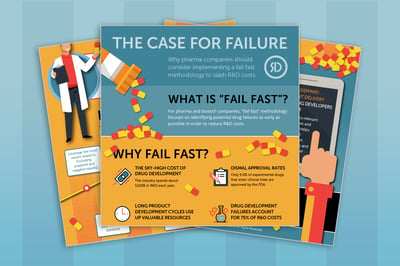Last fall, we published a white paper on how pharma and biotech can apply the concept of "fail fast" to help lower their R&D drug development costs. Based on the attention that the white paper has received, we developed an infographic that provides an at-a-glance overview of the methodology’s key benefits for pharmaceutical companies. Because there’s so much buzz around Fail Fast these days, we decided to devote another blog post to the topic to answer lingering questions for our readers:
Q: Why has Fail Fast gained popularity in drug development circles?
A: Fail Fast methodology has proven itself a game changer for technology companies as they strive to bring new software to market faster than their competitors. More recently, biotech and pharmaceutical companies have followed suit, adapting the fundamentals of the approach to fit the industry’s needs—with the overarching goals of reducing R&D costs, while shortening protracted drug development lifecycles.
Q: Does Fail Fast benefit patients or pharma companies?
A: Fail Fast has the potential to benefit both drug companies and patients alike. For research-driven drug companies, the benefits are clear: if even a few years can be shaved from the length of the product development cycle, the potential cost savings are enormous. In addition, companies will become better able to get useful—or even lifesaving—medicines into the hands of the patients who need them more quickly.
Q: If Fail Fast is so great, why haven’t all drug-development companies adopted this approach?
A: Despite its potential, actually implementing Fail Fast methodology within a real-world drug research and development workflow can be challenging. Not all parts of the process are amenable to change. It is, for instance, often unfeasible to speed the process of recruiting patients into clinical trials. And it’s usually impossible to detect signs of a drug’s efficacy at the low doses with which early trials must begin. What’s key is identifying those parts of the drug discovery and development process that can most readily be made more efficient. Giving researchers instant access to accurate information about the outcomes obtained in relevant studies and trials, for instance, enables them to make smarter and better-informed decisions about which lines of inquiry to halt and which to pursue.
To take even a deeper dive into Fail Fast , read our whitepaper
Leah Rodriguez | VP of Marketing
Leah has over 17 years of experience in publishing and software with various roles leading and developing marketing teams. Prior to joining Research Solutions, she was at Nature Publishing Group, launching marketing for their open access journals, Nature Communications and Scientific Reports and at PLOS, developing...



